Abstract
Lymphokine-rich supernates from normal human peripheral blood mononuclear cells, stimulated by the mitogen phytohemagglutinin, have been shown to cause enhanced collagen accumulation by human embryonic lung fibroblasts (WI-38), as measured by hydroxyproline content of fibroblast monolayers, [14C] proline incorporation into soluble collagen and collagenase release of radioactivity in supernates and monolayers of cultures incubated with [14C] proline. This fibroblast-stimulating activity, demonstrable by suitable dilutions of the supernates, coexisted with a number of other lymphokine activities such as lymphotoxin, proliferation inhibitory factor, and cloning inhibitory factor, which tend to reduce the numbers of function of fibroblasts. The increased content of collagen appeared to be the product of selected surviving and responding fibroblasts. The factor causing this increased collagen accumulation was nondialyzable and stable at -70 degrees C. It represents the first described lymphoid cell-derived activity capable of enhancing collagen accumulation. Fibroblast-stimulating activity may be implicated in the abnormal fibrosis seen in association with chronic inflammation in a variety of disease states. It may have special relevance to progressive systemic sclerosis.
Full text
PDF
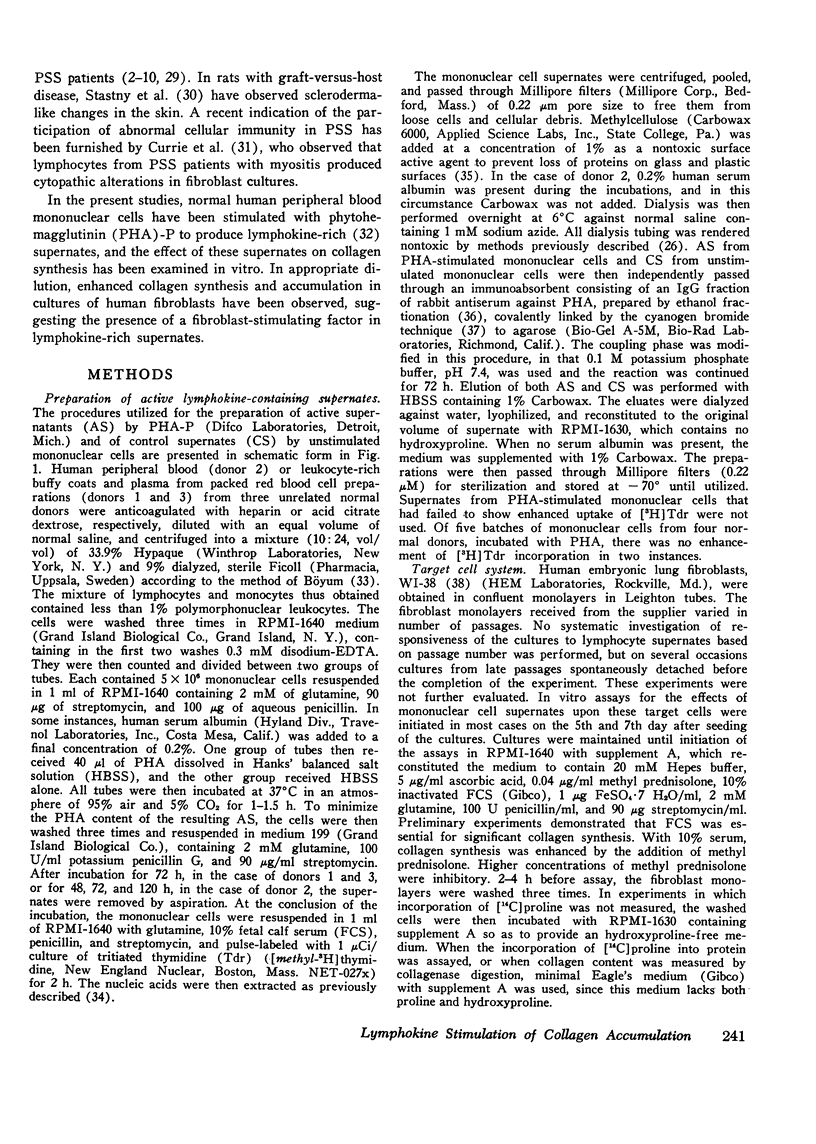

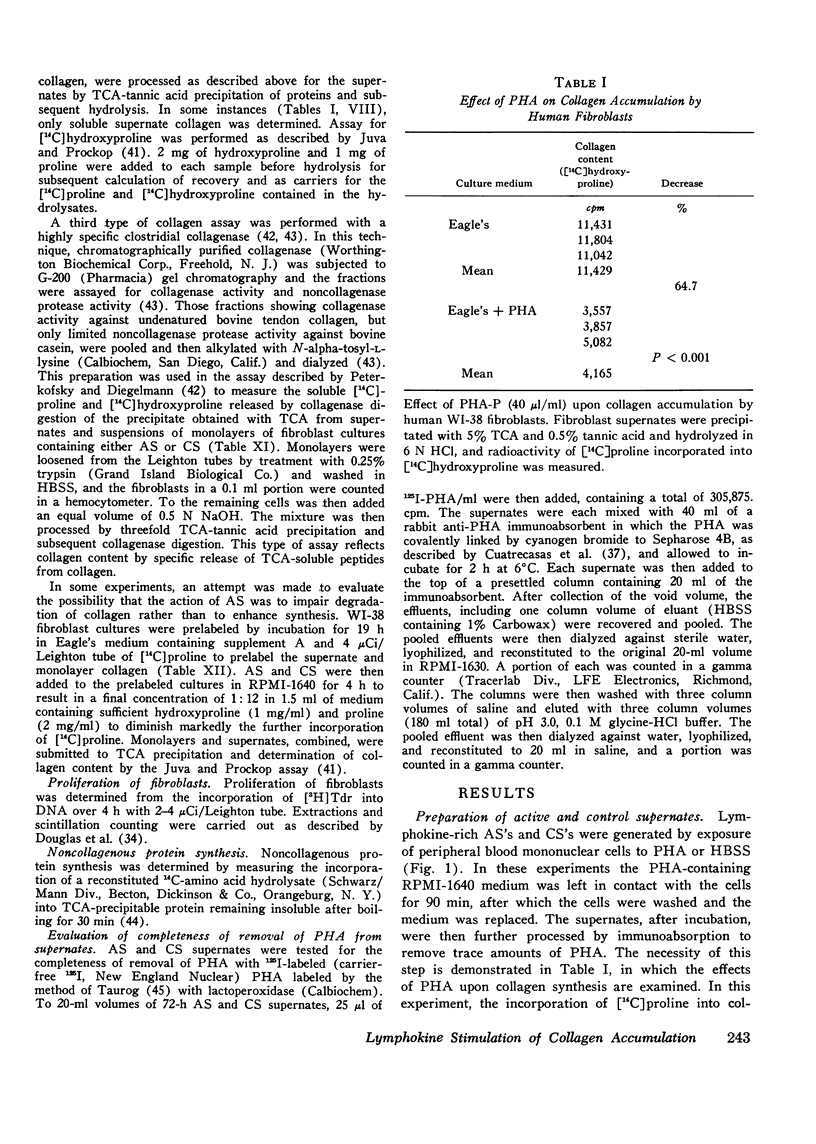


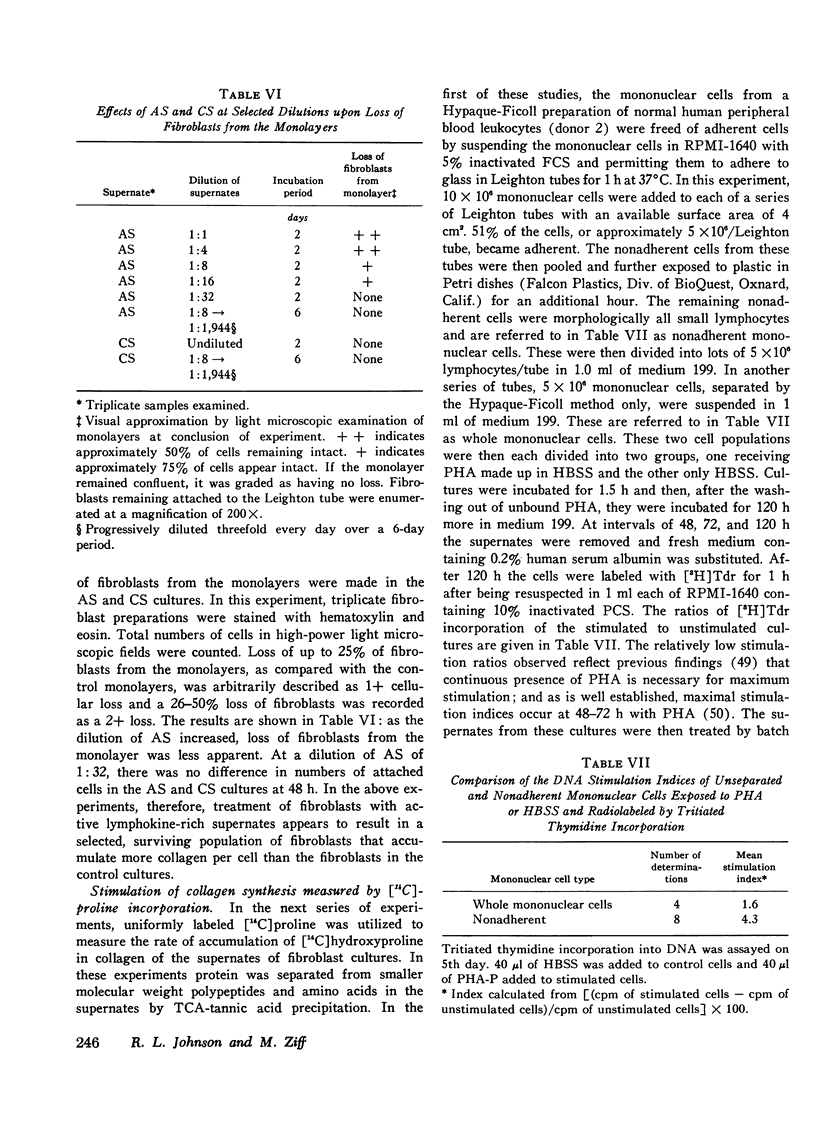

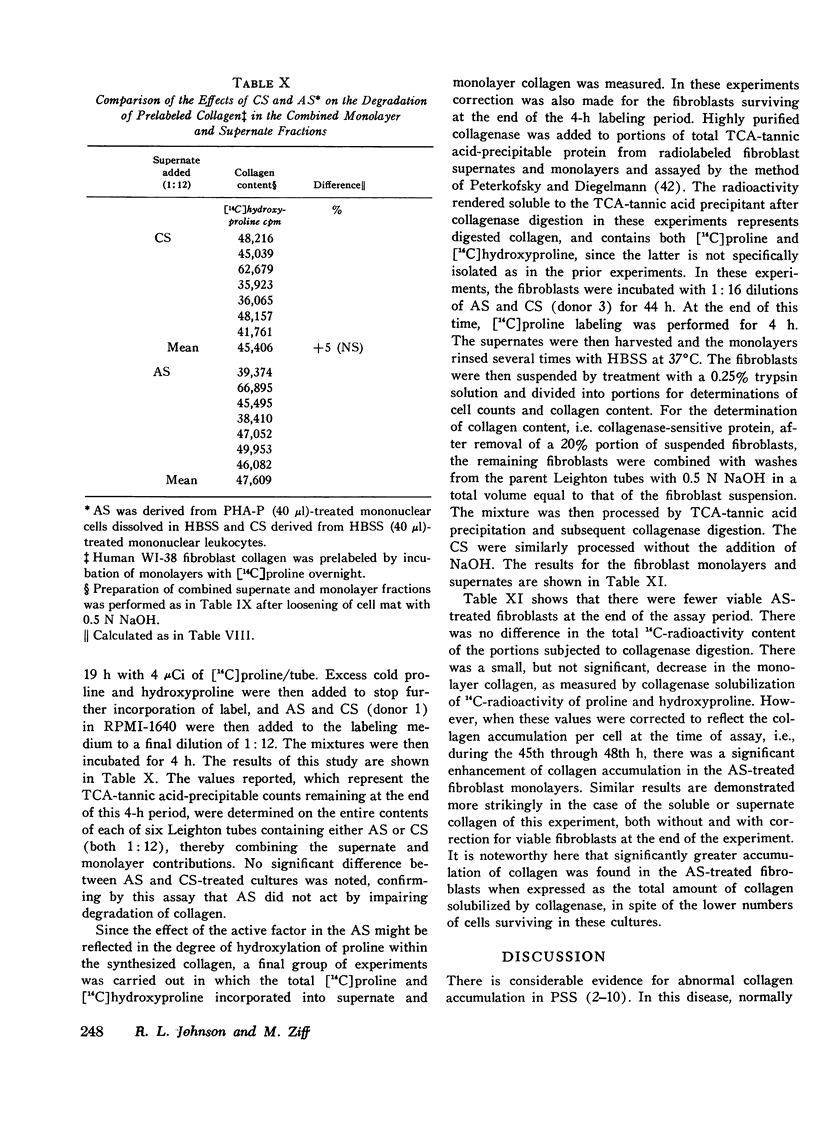

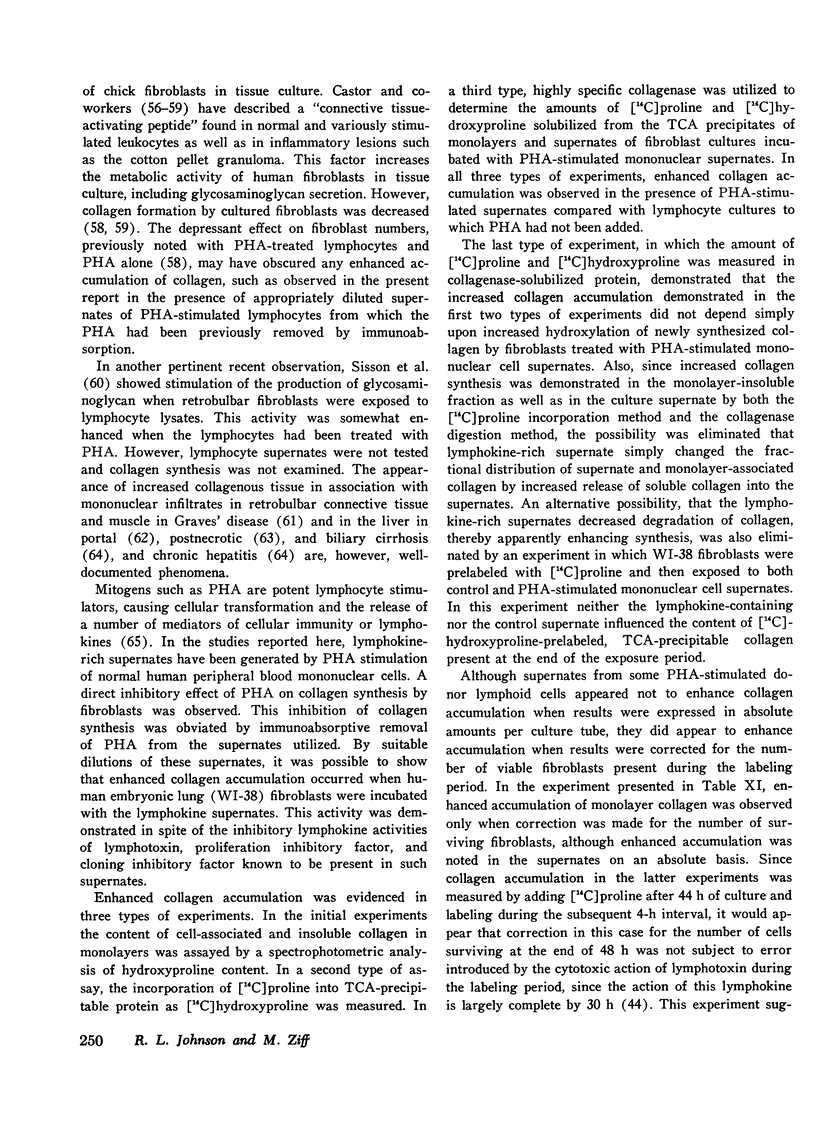
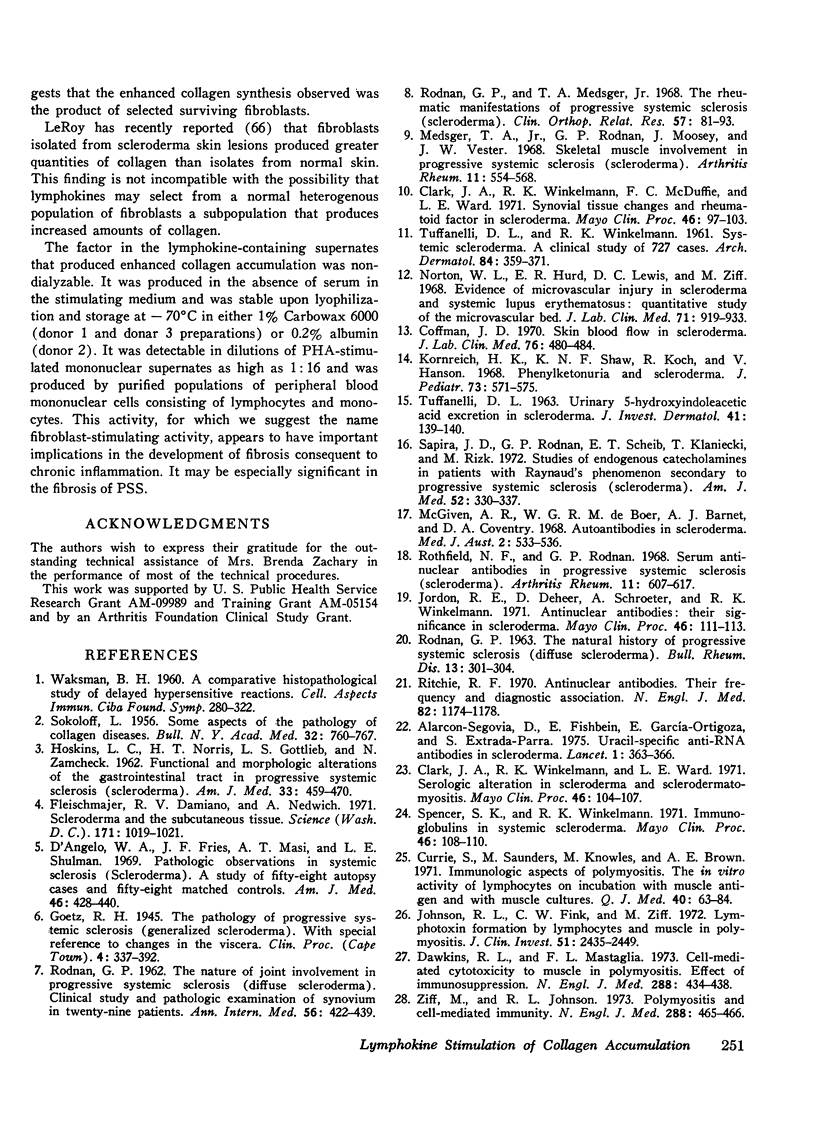
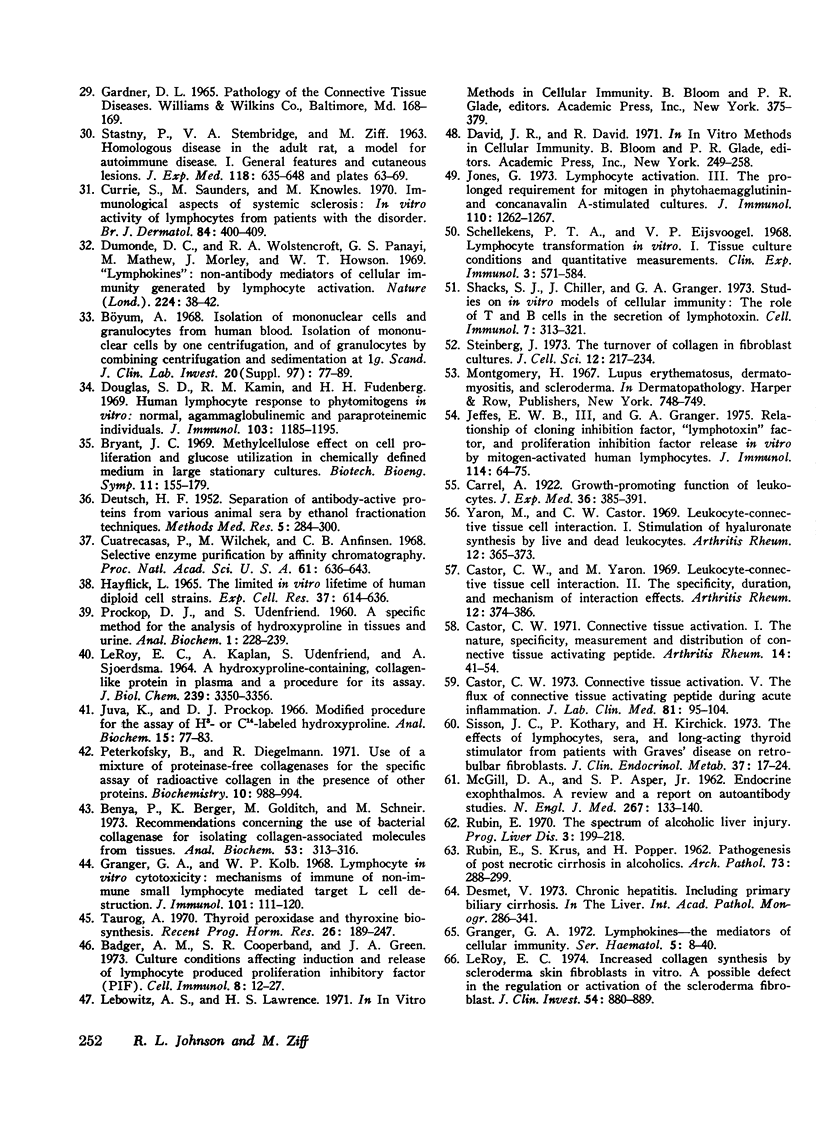
Selected References
These references are in PubMed. This may not be the complete list of references from this article.
- Alarcón-Segovia D., Fishbein E., García-Ortigoza E., Estrada-Parra S. Uracil-specific anti-R.N.A. antibodies in scleroderma. Lancet. 1975 Feb 15;1(7903):363–366. doi: 10.1016/s0140-6736(75)91279-9. [DOI] [PubMed] [Google Scholar]
- Badger A. M., Cooperband S. R., Green J. A. Culture conditions affecting induction and release of lymphocyte produced proliferation inhibitory factor (PIF). Cell Immunol. 1973 Jul;8(1):12–27. doi: 10.1016/0008-8749(73)90089-0. [DOI] [PubMed] [Google Scholar]
- Benya P., Berger K., Golditch M., Schneir M. Recommendations concerning the use of bacterial collagenase for isolating collagen-associated molecules from tissues. Anal Biochem. 1973 May;53(1):313–316. doi: 10.1016/0003-2697(73)90438-7. [DOI] [PubMed] [Google Scholar]
- Bryant J. C. Methylcellulose effect on cell proliferation and glucose utilization in chemically defined medium in large stationary cultures. Biotechnol Bioeng. 1969 Mar;11(2):155–179. doi: 10.1002/bit.260110205. [DOI] [PubMed] [Google Scholar]
- Böyum A. Isolation of mononuclear cells and granulocytes from human blood. Isolation of monuclear cells by one centrifugation, and of granulocytes by combining centrifugation and sedimentation at 1 g. Scand J Clin Lab Invest Suppl. 1968;97:77–89. [PubMed] [Google Scholar]
- Castor C. W. Connective tissue activation. I. The nature, specificity, measurement and distribution of connective tissue activating peptide. Arthritis Rheum. 1971 Jan-Feb;14(1):41–54. doi: 10.1002/art.1780140107. [DOI] [PubMed] [Google Scholar]
- Castor C. W. Connective tissue activation. V. The flux of connective tissue activating peptide during acute inflammation. J Lab Clin Med. 1973 Jan;81(1):95–104. [PubMed] [Google Scholar]
- Castor C. W., Yaron M. Leukocyte-connective tissue cell interaction. II. The specificity, duration, and mechanism of interaction effects. Arthritis Rheum. 1969 Aug;12(4):374–386. doi: 10.1002/art.1780120405. [DOI] [PubMed] [Google Scholar]
- Clark J. A., Winkelmann R. K., McDuffie F. C., Ward L. E. Synovial tissue changes and rheumatoid factor in scleroderma. Mayo Clin Proc. 1971 Feb;46(2):97–103. [PubMed] [Google Scholar]
- Clark J. A., Winkelmann R. K., Ward L. E. Serologic alterations in scleroderma and sclerodermatomyositis. Mayo Clin Proc. 1971 Feb;46(2):104–107. [PubMed] [Google Scholar]
- Coffman J. D. Skin blood flow in scleroderma. J Lab Clin Med. 1970 Sep;76(3):480–484. [PubMed] [Google Scholar]
- Cuatrecasas P., Wilchek M., Anfinsen C. B. Selective enzyme purification by affinity chromatography. Proc Natl Acad Sci U S A. 1968 Oct;61(2):636–643. doi: 10.1073/pnas.61.2.636. [DOI] [PMC free article] [PubMed] [Google Scholar]
- Currie S., Saunders M., Knowles M., Brown A. E. Immunological aspects of polymyositis. The in vitro activity of lymphocytes on incubation with muscle antigen and with muscle cultures. Q J Med. 1971 Jan;40(157):63–84. [PubMed] [Google Scholar]
- Currie S., Saunders M., Knowles M. Immunological aspects of systemic sclerosis in vitro activity of lymphocytes from patients with the disorder. Br J Dermatol. 1971 May;84(5):400–409. doi: 10.1111/j.1365-2133.1971.tb02523.x. [DOI] [PubMed] [Google Scholar]
- D'Angelo W. A., Fries J. F., Masi A. T., Shulman L. E. Pathologic observations in systemic sclerosis (scleroderma). A study of fifty-eight autopsy cases and fifty-eight matched controls. Am J Med. 1969 Mar;46(3):428–440. doi: 10.1016/0002-9343(69)90044-8. [DOI] [PubMed] [Google Scholar]
- DEUTSCH H. F. II. Separation of antibody-active proteins from various animal sera by ethanol fractionation techniques. Methods Med Res. 1952;5:284–300. [PubMed] [Google Scholar]
- Dawkins R. L., Mastaglia F. L. Cell-mediated cytotoxicity to muscle in polymyositis. Effect of immunosuppression. N Engl J Med. 1973 Mar 1;288(9):434–438. doi: 10.1056/NEJM197303012880903. [DOI] [PubMed] [Google Scholar]
- Douglas S. D., Kamin R. M., Fudenberg H. H. Human lymphocyte response to phytomitogens in vitro: normal, agammaglobulinemic and paraproteinemic individuals. J Immunol. 1969 Dec;103(6):1185–1195. [PubMed] [Google Scholar]
- Dumonde D. C., Wolstencroft R. A., Panayi G. S., Matthew M., Morley J., Howson W. T. "Lymphokines": non-antibody mediators of cellular immunity generated by lymphocyte activation. Nature. 1969 Oct 4;224(5214):38–42. doi: 10.1038/224038a0. [DOI] [PubMed] [Google Scholar]
- Fleischmajer R., Damiano V., Nedwich A. Scleroderma and the subcutaneous tissue. Science. 1971 Mar 12;171(3975):1019–1021. doi: 10.1126/science.171.3975.1019. [DOI] [PubMed] [Google Scholar]
- Granger G. A., Kolb W. P. Lymphocyte in vitro cytotoxicity: mechanisms of immune and non-immune small lymphocyte mediated target L cell destruction. J Immunol. 1968 Jul;101(1):111–120. [PubMed] [Google Scholar]
- Granger G. A. Lymphokines--the mediators of cellular immunity. Ser Haematol. 1972;5(4):8–40. [PubMed] [Google Scholar]
- HAYFLICK L. THE LIMITED IN VITRO LIFETIME OF HUMAN DIPLOID CELL STRAINS. Exp Cell Res. 1965 Mar;37:614–636. doi: 10.1016/0014-4827(65)90211-9. [DOI] [PubMed] [Google Scholar]
- HOSKINS L. C., NORRIS H. T., GOTTLIEB L. S., ZAMCHECK N. Functional and morphologic alterations of the gastrointestinal tract in progressive systemic sclerosis (scleroderma). Am J Med. 1962 Sep;33:459–470. doi: 10.1016/0002-9343(62)90241-3. [DOI] [PubMed] [Google Scholar]
- Jeffes E. W., Granger G. A. Relationship of cloning inhibition factor, "lymphotoxin" factor, and proliferation inhibition factor release in vitro by mitogen-activated human lymphoctes. J Immunol. 1975 Jan;114(1 Pt 1):64–69. [PubMed] [Google Scholar]
- Johnson R. L., Fink C. W., Ziff M. Lymphotoxin formation by lymphocytes and muscle in polymyositis. J Clin Invest. 1972 Sep;51(9):2435–2449. doi: 10.1172/JCI107057. [DOI] [PMC free article] [PubMed] [Google Scholar]
- Jones G. Lymphocyte activation. 3. The prolonged requirement for mitogen in phytohaemagglutinin- and concanavalin A-stimulated cultures. J Immunol. 1973 May;110(5):1262–1267. [PubMed] [Google Scholar]
- Jordon R. E., Deheer D., Schroeter A., Winkelmann R. K. Antinuclear antibodies: their significance in scleroderma. Mayo Clin Proc. 1971 Feb;46(2):111–113. [PubMed] [Google Scholar]
- Kornreich H. K., Shaw K. N., Koch R., Hanson V. Phenylketonuria and scleroderma. J Pediatr. 1968 Oct;73(4):571–575. doi: 10.1016/s0022-3476(68)80272-0. [DOI] [PubMed] [Google Scholar]
- LEROY E. C., KAPLAN A., UDENFRIEND S., SJOERDSMA A. A HYDROXYPROLINE-CONTAINING, COLLAGEN-LIKE PROTEIN IN PLASMA AND A PROCEDURE FOR ITS ASSAY. J Biol Chem. 1964 Oct;239:3350–3356. [PubMed] [Google Scholar]
- LeRoy E. C. Increased collagen synthesis by scleroderma skin fibroblasts in vitro: a possible defect in the regulation or activation of the scleroderma fibroblast. J Clin Invest. 1974 Oct;54(4):880–889. doi: 10.1172/JCI107827. [DOI] [PMC free article] [PubMed] [Google Scholar]
- McGiven A. R., de Boer W. G., Barnett A. J., Coventry D. A. Autoantibodies in scleroderma. Med J Aust. 1968 Sep 28;2(13):533–536. doi: 10.5694/j.1326-5377.1968.tb83002.x. [DOI] [PubMed] [Google Scholar]
- Medsger T. A., Jr, Rodnan G. P., Moossy J., Vester J. W. Skeletal muscle involvement in progressive systemic sclerosis (scleroderma). Arthritis Rheum. 1968 Aug;11(4):554–568. doi: 10.1002/art.1780110405. [DOI] [PubMed] [Google Scholar]
- Norton W. L., Hurd E. R., Lewis D. C., Ziff M. Evidence of microvascular injury in scleroderma and systemic lupus erythematosus: quantitative study of the microvascular bed. J Lab Clin Med. 1968 Jun;71(6):919–933. [PubMed] [Google Scholar]
- PROCKOP D. J., UDENFRIEND S. A specific method for the analysis of hydroxyproline in tissues and urine. Anal Biochem. 1960 Nov;1:228–239. doi: 10.1016/0003-2697(60)90050-6. [DOI] [PubMed] [Google Scholar]
- Peterkofsky B., Diegelmann R. Use of a mixture of proteinase-free collagenases for the specific assay of radioactive collagen in the presence of other proteins. Biochemistry. 1971 Mar 16;10(6):988–994. doi: 10.1021/bi00782a009. [DOI] [PubMed] [Google Scholar]
- RODNAN G. P. The natural history of progressive systemic sclerosis (diffuse scleroderma). Bull Rheum Dis. 1963 Feb;13:301–304. [PubMed] [Google Scholar]
- RODNAN G. P. The nature of joint involvement in progressive systemic sclerosis (diffuse scleroderma). Ann Intern Med. 1962 Mar;56:422–439. doi: 10.7326/0003-4819-56-3-422. [DOI] [PubMed] [Google Scholar]
- RUBIN E., KRUS S., POPPER H. Pathogenesis of postnecrotic cirrhosis in alcoholics. Arch Pathol. 1962 Apr;73:288–299. [PubMed] [Google Scholar]
- Ritchie R. F. Antinucleolar antibodies. Their frequency and diagnostic association. N Engl J Med. 1970 May 21;282(21):1174–1178. doi: 10.1056/NEJM197005212822104. [DOI] [PubMed] [Google Scholar]
- Rodnan G. P., Medsger T. A. The rheumatic manifestaions of progressive systemic sclerosis (scleroderma). Clin Orthop Relat Res. 1968 Mar-Apr;57:81–93. [PubMed] [Google Scholar]
- Rothfield N. F., Rodnan G. P. Serum antinuclear antibodies in progressive systemic sclerosis (scleroderma). Arthritis Rheum. 1968 Oct;11(5):607–617. doi: 10.1002/art.1780110502. [DOI] [PubMed] [Google Scholar]
- STASTNY P., STEMBRIDGE V. A., ZIFF M. HOMOLOGOUS DISEASE IN THE ADULT RAT, A MODEL FOR AUTOIMMUNE DISEASE. I. GENERAL FEATURES AND CUTANEOUS LESIONS. J Exp Med. 1963 Oct 1;118:635–648. doi: 10.1084/jem.118.4.635. [DOI] [PMC free article] [PubMed] [Google Scholar]
- Sapira J. D., Rodnan G. P., Scheib E. T., Klaniecki T., Rizk M. Studies of endogenous catecholamines in patients with Raynaud's phenomenon secondary to progressive systemic sclerosis (scleroderma). Am J Med. 1972 Mar;52(3):330–337. doi: 10.1016/0002-9343(72)90020-4. [DOI] [PubMed] [Google Scholar]
- Schellekens P. T., Eijsvoogel V. P. Lymphocyte transformation in vitro. I. Tissue culture conditions and quantitative measurements. Clin Exp Immunol. 1968 Jul;3(6):571–584. [PMC free article] [PubMed] [Google Scholar]
- Shacks S. J., Chiller J., Granger G. A. Studies on in vitro models of cellular immunity: the role of T and B cells in the secretion of lymphotoxin. Cell Immunol. 1973 May;7(2):313–321. doi: 10.1016/0008-8749(73)90253-0. [DOI] [PubMed] [Google Scholar]
- Sisson J. C., Kothary P., Kirchick H. The effects of lymphocytes, sera, and long-acting thyroid stimulator from patients with Graves' disease on retrobulbar fibroblasts. J Clin Endocrinol Metab. 1973 Jul;37(1):17–24. doi: 10.1210/jcem-37-1-17. [DOI] [PubMed] [Google Scholar]
- Spencer S. K., Winkelmann R. K. Immunoglobulins in systemic scleroderma. Mayo Clin Proc. 1971 Feb;46(2):108–110. [PubMed] [Google Scholar]
- Steinberg J. The turnover of collagen in fibroblast cultures. J Cell Sci. 1973 Jan;12(1):217–234. doi: 10.1242/jcs.12.1.217. [DOI] [PubMed] [Google Scholar]
- TUFFANELLI D. L. URINARY 5-HYDROXYINDOLEACETIC ACID EXCRETION IN SCLERODERMA. J Invest Dermatol. 1963 Sep;41:139–140. doi: 10.1038/jid.1963.88. [DOI] [PubMed] [Google Scholar]
- TUFFANELLI D. L., WINKELMANN R. K. Systemic scleroderma, A clinical study of 727 cases. Arch Dermatol. 1961 Sep;84:359–371. doi: 10.1001/archderm.1961.01580150005001. [DOI] [PubMed] [Google Scholar]
- Taurog A. Thyroid peroxidase and thyroxine biosynthesis. Recent Prog Horm Res. 1970;26:189–247. doi: 10.1016/b978-0-12-571126-5.50009-1. [DOI] [PubMed] [Google Scholar]
- Ziff M., Johnson R. L. Polymyositis and cell-mediated immunity. N Engl J Med. 1973 Mar 1;288(9):465–466. doi: 10.1056/NEJM197303012880910. [DOI] [PubMed] [Google Scholar]


